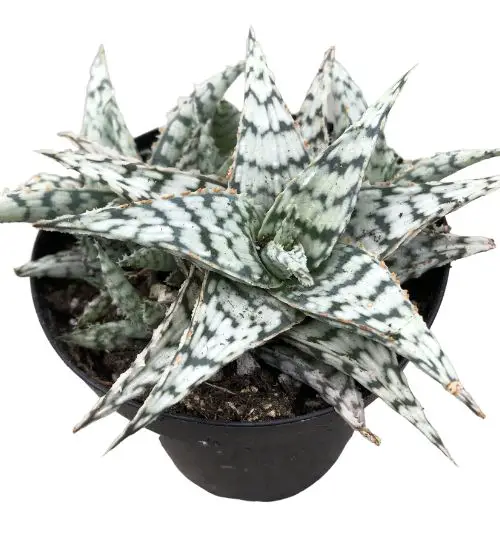Sun: Bright indoor light
Water: Typical water needs for a succulent
Temperature: Zone 10a from 30° F to 35° F (-1.1 ° C to 1.7° C) to Zone 11b from 45° F to 50° F (7.2° C to 10° C)
Winter Survival: Not cold hardy
Propagation: leaves, offsets, cuttings, seeds
Flower: in late winter or early spring
Flower Type: coral
Toxic: Toxic to humans and animals
Dormant: winter
Space Requirement: Indoors
Common Problems: No major pests, Plants may rot if overwatered
Where to buy Aloe Blizzard?
Basc Care for Aloe Blizzard
Watering
Can you water your succulent more than what its need? The answer is yes and no. In extreme conditions, you can water your plants more often when you notice the soil is completely dry.
One simple tip for you is that you can use some online apps to check the soil status before you go water your succulents. I would recommend the ThePlantsCheck app, it has some nice features there.
Fertilizing
Only feed this succulent during its active growing seasons which means no information. Use the right fertilizer applied in the right amounts. Applying half-strength balanced fertilizer every month or so is recommended for optimal results.
Do not fertilize during winter as the plant is dormant.
Sun & Location Requirements for "Aloe Blizzard"
Aloe Blizzard needs lots of sunshine! An ideal spot is near a window that gets direct sun for a few hours every day. If you don’t have natural sunlight indoors, consider investing in an LED grow-light to provide enough light for Aloe Blizzard to stay healthy and vibrant.
As per this succulent profile, it is only able to stay healthy when the environment temperature is above the range of zone 10a from 30° F to 35° F (-1.1 ° C to 1.7° C).
In order to protect Aloe Blizzard from freezing temperatures, it is important to provide adequate insulation and drainage. A layer of mulch or gravel will help protect the roots by keeping them warm during cold weather. In addition, protection from wind and sun exposure can help reduce the chances of frost damage.
Any succulents in the group will only need minimal space to grow. You can place your pot at your table or window. Outdoors is also a nice idea to put your pot.
Aloe Blizzard also benefits from some indirect light throughout the day as well, so make sure you give it enough space to soak up light without becoming too exposed to heat.
Propagation
Propagating succulents with leaves is a satisfying way to obtain new plants. Start by cutting some healthy leaves from the mother plant, then place them on top of potting mix and water regularly. In time you'll have vibrant succulents that you grew yourself!
One way to propagate Aloe Blizzard is by offsets. Taking an offset from the mother plant and potting it into soil will give you a brand new succulent with minimal effort.
One way to propagate Aloe Blizzard is by cutting
Propagating Aloe Blizzard from seeds is a great way to produce new plants without relying on cuttings or divisions. It's important to look for healthy, dark and plump seeds that are slightly sticky when touched. The soil should be pre-mixed with well-draining potting mix, before evenly sowing the seeds and pressing them into the surface. To ensure successful germination, gentle misting of the soil should be done and placed in indirect light.
Toxicity

Aloe Blizzard is a highly toxic plant and should be handled with extreme caution. Ingestion can cause nausea, vomiting and other serious health issues in both humans and animals alike.
Pests and Diseases
Aloe Blizzard is not affected too much by common pests and diseases like most of the other succulents.


